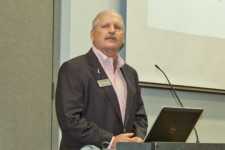Revolution In Education

This year, land grant universities will celebrate their 150th anniversary. These schools were established by an act supported by Congressman Justin Smith Morrill of Vermont. The bill passed through Congress in 1859, but was vetoed by President James Buchanan. When Abraham Lincoln was elected, Morrill submitted the legislation again, and Lincoln signed it into law in 1862.
According to Jack Payne, senior vice president of UF/IFAS, the Morrill Act was revolutionary in scope. UF/IFAS is one of Florida’s land grant universities, along with Florida A&M.
“Back in the middle 1800s, higher education was based on the European model, which was basically education for the leisure classes and professionals,” says Payne. “But, with the majority of new Americans being farmers and mechanics, there was concern about the future success of the country if we couldn’t get these folks educated.
“Passage of the Morrill Act is considered revolutionary by people who know about and study higher education. When we think about our American Revolution from England, this was on the same scale in terms of higher education. It transformed access to economic opportunity.”
30,000 Acres
The law granted 30,000 acres of federal land back to the states for each congressman in individual states. The states were to take this land and build a public university on it or sell the land and use the funds to build a university.
Some 150 years later, many of the important public research universities in the country have grown out of the Morrill Act. The University of Florida, University of California-Berkeley, Massachusetts Institute of Technology, Texas A&M, and many more are important land grants. “You can argue that what the land grant schools did back then and continue to do today has really helped build this country,” says Payne.
Following the Morrill Act, which created education, two other acts helped create the “three-legged” stool that we think of today. In 1887, the Hatch Act created the experiment stations, which added the research element of the stool. The Smith-Lever Act created the Extension element in 1914.
Major Reach
The impact of land grant universities is significant, with more than 3 million students enrolled in these schools each year. About a half million students graduate from land grants each year and a third of bachelor and master degrees come from these colleges. When you look at higher degrees, the numbers are even more impressive, with 60% of all PhDs and 70% of all engineering degrees originating from land grant universities.
In Florida, the impact of its land grant education, research, and Extension has been significant. Consider the state’s blueberry industry, which has grown into a $70 million industry. Today, 98% of blueberry varieties grown in the state have been developed by UF/IFAS. Strawberries make up a $300 million industry, with 60% of varieties developed by the university.
“You can look at the Citrus Research and Education Center station in Lake Alfred,” says Payne. “This citrus station that has been there for more than 90 years and science that has been developed there has really enabled the citrus industry in our state to become such an important part of our ag sector. And, it continues to support the industry.”
Future Demands
In October 2011, the world population surpassed the 7 billion mark. In the next 50 years, the population is projected to grow to 9 billion. These people must be on fed on existing arable lands, which presents a tremendous challenge.
According to Payne, agriculture must experience a second green revolution. The “father” of the first revolution is the late Nobel Peace Prize winner Norman Borlaug, whose wheat varieties are credited with saving 2 billion people from starvation.
“I like to repeat Borlaug’s famous quote that we have to grow more food in the next 50 years than we have grown in the past 1,500 to feed the increase in world population,” says Payne. “We have the challenge of growing more food when there is no more land to grow it on. This second green revolution will be in the hands of ag scientist like those at UF/IFAS and other land grant universities.”
Payne adds that he hopes lawmakers remember the critically important role of land grants in meeting the food demands of the global population when making decisions on funding and budgeting issues. “Understanding the troubled budget situation, people must appreciate the role that science has had in providing an abundant and cheap food supply.”










